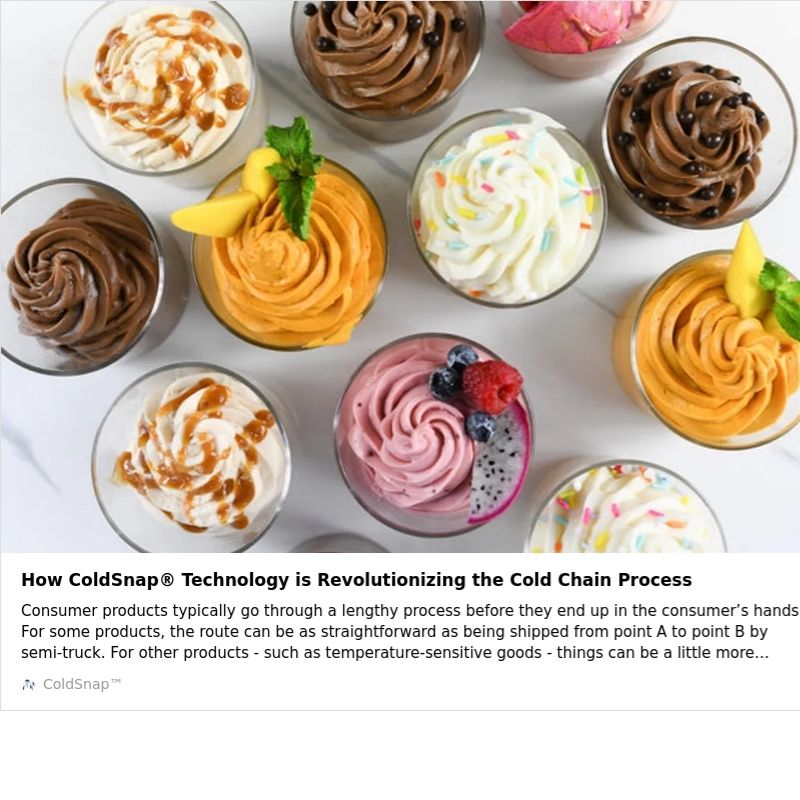Consumer products typically go through a lengthy process before they end up in the consumer’s hands. For some products, the route can be as straightforward as being shipped from point A to point B by semi-truck. For other products – such as temperature-sensitive goods – things can be a little more complicated.
Read on to learn more about how ColdSnap is utilizing cutting-edge technology to reduce carbon emissions and fundamentally change the cold chain landscape.
What is the Cold Chain?
The “cold chain” describes the transportation of temperature-sensitive products along a supply chain. Cold chain transportation typically uses refrigerated packaging methods (i.e. coolers or ice) and logistical planning (i.e. mitigating transportation times) to protect the integrity of shipments.
Think about all the products we use on a daily basis that need to be kept at certain temperatures. From your favorite frozen treats to meats to important medications, it is estimated that 40% of all food and beverage products and 80% of life sciences products require cold chain transportation. Experts agree that these numbers are on the rise.
Effects of the Cold Chain Process
The cold chain has, historically, required high levels of innovation to help meet the surge in demand for perishable products. The demand for perishable products continues to grow and, when combined with global warming patterns, requires even more cold chain innovation.
There are two primary types of cold chain systems: active and passive. Active cold chain systems consist of transport containers outfitted with electric or battery-powered temperature controls; these systems often rely on dry ice as a coolant. Passive cold chains, on the other hand, typically utilize polyurethane or polystyrene insulation or vacuum-insulated panels that maintain tighter seals that can keep consistent temperatures for up to 96 hours.
Both systems have their pros and cons, but one thing is for certain: both active and passive cold chain systems contribute detrimental carbon emissions to the earth’s atmosphere. It is estimated that cold storage contributes approximately 1% to the world’s CO2 emissions. This contribution is expected to increase over the coming years as demand for temperature-sensitive products increases.
The cold chain process presents a classic “catch-22.” Climate change means we will need more cold storage, and cold chain packaging is also essential for fighting food waste. However, it also plays a part in exacerbating the climate problem.
Revolutionizing the Cold Supply Chain
ColdSnap understands the need for a more effective and environmentally-conscious way to produce and distribute frozen confections. ColdSnap pods are shelf-stable at ambient temperature and do not require refrigeration during the transportation and storage processes.
Overall, ColdSnap’s innovative approach to frozen treats and the cold chain can cut back on costs and carbon footprint – a dual benefit that was once thought to be unattainable in the frozen dessert space.
About ColdSnap
ColdSnap is a soon-to-be-released rapid-freezing appliance that produces single servings of frozen confections and frozen beverages in approximately 2 minutes. Contact us today or visit our blog for more information on the cold chain process and more.
Get the Scoop
Stay in the loop on all things ColdSnap with our newsletter.
Categories
Recent Posts
- ColdSnap Partners With Foodbuy to Deliver On-Demand Frozen Treats to Foodservice Operators
- Your Morning Just Got a Whole Lot Smoother: How to Make a Delicious & Healthy Smoothie with ColdSnap
- 7 Reasons Every Golf Course Needs a ColdSnap Machine
- Empowering Students with Self-Serve Frozen Treats — No Hassle, All Joy
- Ice Cream on Demand…From a Can??


